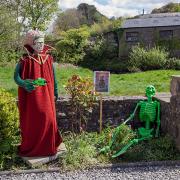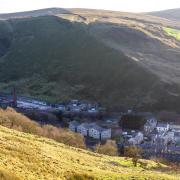Hedges are amazing. While we see them all the time and may take them for granted, a lovely mixed species native hedge is an absolute gift for wildlife. Not only do they provide food and shelter, but they also act like wildlife motorways, allowing everything from field voles to great crested newts to move around, allowing populations to spread and connect up and access new habitats.
However, we have lost 50 per cent of our hedgerows since World War Two – and around 60 per cent of the hedgerows that remain are not in a good condition.
Hedgerows used to provide vital boundaries, keeping livestock where they were supposed to be without the need for barbed wire. But many of our hedges are bare all winter and have huge gaps at the bottom which any sheep could run straight through.

One answer is to add fencing into the hedge, but the other is the traditional art of hedgelaying. Traditionally, throughout winter people would have been engaged in ‘laying’ their hedges, forming a natural livestock-proof barrier – and an amazing habitat for wildlife.
The Lancashire Wildlife Trust has a band of conservation officers and skilled volunteers who work to lay hedges across many nature reserves and other wild places, including Brockholes near Preston, Foxhill Bank near Clitheroe, Cutacre near Bolton, and in Phillips Park in Bury.
I recently spent a day with the hedgelaying team where funding from the National Highways Network 4 Nature scheme is supporting volunteers to lay and regenerate 150m of hedges.

My tutor for the day was Francis Williams who, along with his hedgelaying partner, Ann Shaw, were the deserved winners of the Trust’s ‘Most Inspirational Volunteers of the Year’ award. I’d already met Ann and Francis while they were busy laying hedges at the Cutacre nature reserve and had been given a thorough grounding in what hedgelaying entails.
We stacked our tools in Francis’ trusty repurposed golf trolley and set off for our section of hedge – a tricky bit of overgrown hawthorn we were laying around a lovely mature tree. The principle of hedgelaying is to take the upright stems of the plants which are forming the hedge, make a cut into them near to the base, but not all the way though, and then lay these stems (also known as pleachers, or liggers in Lancashire dialect) at an angle along the length of the hedge.
The pleacher stays, alive sprouting leaves and more branches, throughout the growing season which helps to strengthen and thicken the hedge, while the remaining stump (the ‘heel’) acts as if coppiced and sends up new stems which in time will be laid into the hedge to maintain it.

It may all sound simple, but I can promise you, it’s not!
Through years of accumulated skill and knowledge, Francis can look at an area of hedge and know exactly which stems to take out and which to lay where to ensure the hedge is thick and strong for at least the next 10 years (by which time it will be ready to lay again with the new stems that have grown from the heel). But the real skill comes in making the cut that forms the pleacher.
The perfect pleacher comes from a long tapering cut that starts four times the width of the stem up on the opposite side to where it will bend. The heel retains most of the width with the pleacher hanging on by just a thin strip of wood.
A few thwacks from Francis’ trusty billhook (you can also use an axe or a chainsaw) should have been all it took, but most of my cuts ended up in the wrong place. However, Francis’ calm guidance saw me get there in the end, with pleacher formed, heel tidied up, and stem laid alongside the others forming the new section of laid hedge.

Hedgelaying is an artform. One which my farming grandad was a champion at – and one which I could happily spend all day every day learning to perfect. These traditional skills have lasted for a reason, and show how human action and supporting wildlife can go hand in hand. A laid hedge is thick and strong, providing the perfect habitat for birds to nest, insects to shelter, and mammals and reptiles to safely move around.



























